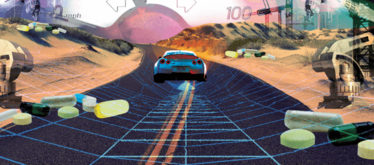
Revving Up for the Revolution: Industry 4.0
We’re moving towards a data-driven future of enhanced manufacturing. And we must lay the foundations today.
Gareth Jenkins | | Longer Read

Over the span of my career, I’ve always been interested in how advances in science and technology can help us to reinvent approaches to pharmaceutical development – and how we can use those advantages to increase speed and efficiency. In essence, we must always look to how we can harness the latest technology and process innovations to improve what we’re doing. The comprehensive approach to continuous improvement through automation and data-exchange spans many industries, and is generally known as “Industry 4.0”. Before joining Arcinova as CSO and leading its innovation and technology strategy, I was the CEO for Britest, a process understanding consultancy business. Back then, a major project for us was a government-funded initiative called ADDOPT, which stands for Advanced Digital Design of Pharmaceutical Therapies. The goal was to examine what was happening as the Industry 4.0 concept took root (including emerging buzzwords and challenges) in other manufacturing industries, and to ask what types of projects would demonstrate the power of the approach. We were also tasked with asking whether it was worthwhile for pharma development and manufacture. (And to cut to the chase: yes, I believe there is considerable and wide-ranging potential value for pharma!)
Origin of Industry 4.0
As a shorthand term, Industry 4.0 means that we are in the early stages of a fourth industrial revolution. For me, this new paradigm is all about innovation in manufacturing. Where it will take us is not yet fully clear, but how we got here is a function of revolutions one through three.
The first industrial revolution in the 18th century, Industry 1.0, was marked by the switch from manually operated machinery to steam-powered industrial machines. It started with looms in the textile industry before spreading elsewhere. It took approximately 70 years, but it completely revolutionized manufacturing by replacing the physical power of human workers with vastly more powerful and efficient machines.
The second industrial revolution, Industry 2.0, occurred around 1870 to 1920, and was characterized by replacing steam with electricity. At the time, pioneers who were interested in applying the new technology had to first generate their own electricity. There was no power grid; you had to build your own power station, and you had to think long and hard about how to invest in it. There’s a historical echo with Industry 4.0 here – both paradigms are about tapping into new resources, and then figuring out if they can be accessed as commodity utilities, or if you’ll need to generate the building blocks in-house before you can reap the advantages.
Beginning in the early 1970s, the third industrial revolution, Industry 3.0, saw the addition of digital technology to monitor and control the function of electrical machinery. The goal became to make production even more efficient and safe using computers, sensors and robotics – the dawn of automation.
The current change – from the third to the fourth industrial revolution – is marked by a move toward a consolidated, full-spectrum, data-driven approach to design and manufacturing. It takes advantage of increasingly powerful digital tools to control and inform the automated process to optimize outcomes. In short, factories are becoming smarter.

The power of connections
Not that long ago, cars had analogue fuel gauges with an indicator needle that moved between full and empty. These gauges were somewhat imprecise – and when the indicator was in the red you were taking a gamble! But they were useful as a rough indicator of your remaining fuel. About 20 years ago, manufacturers began installing digital sensors inside of fuel tanks. These sensors can be calibrated to show the number of liters or gallons remaining in your tank, providing a more precise measure. Car makers also started to install sensors that monitor fuel efficiency. By combining the two pieces of information, the remaining volume of fuel could be translated into the number of miles you can drive before you’re running on empty. The result – car or fuel range – is really a (late) example of an Industry 3.0 transformation, and provided a more useful context-based and quantitative measure for the driver.
An example of Industry 4.0 would be a system that predicts early on when the car’s fuel will run out, and makes plans to avoid the issue – for example, a car that automatically offers a list of open gas stations within the remaining driving range from your location, plotting a route to the one selected. The same principle can be applied to Industry 4.0 in pharma, where “self-aware” equipment components can report on their condition, indicate when maintenance is due, and report on their predicted lifetime. The savings that could be made using this capability are great indeed.
It is this combination of different data sources and control systems that creates new possibilities for better products. Another example within Pharma 4.0 is the development of smart epichlorohydrin auto-injector pens for emergency treatment of anaphylactic shock. These are fitted with sensors that monitor temperature, location and use. They can alert the user when the pen is close to its expiry date or has been exposed to extremes of temperature. More importantly, when the auto-injector is used, it can send a notification, including its location, to a circle of contacts and a pharmacy chain. This triggers the allocation of a replacement auto-injector at the nearest pharmacy for pick up or delivery to the patient within a few hours.
The latter example highlights the potential to gather data from patients and use it to create a feedback loop in the supply chain that allows manufacturers to adjust to changing demand more rapidly – perhaps avoiding the manufacture of drug batches that would remain unused. What if we could drive demand the other way, so that manufacture is perfectly matched to patient demand? The industry wouldn’t need drugs that remain stable for five years because we could use a just-in-time manufacturing approach.
A just-in-time approach could be particularly beneficial for clinical supply. One problem with early-phase clinical trials is the unpredictable time it takes to recruit patients. If you’re dealing with a rare disease, for example, there simply aren’t that many patients available, and it’s difficult to predict how many you’ll get over a set time period. If your two-year clinical trial requires 200 patients, ideally, you’d enroll them at a rate of around 10 patients per week for six months. But what if you recruit one or two in the first month, then none for a month or two, and then another 20 in the same week? It definitely presents uncertainty for clinical supply – how much drug product should be manufactured and when? How do you respond if 30 new patients turn up and you’ve only planned for 10?
In the past, we’ve dealt with this uncertainty by producing an excess quantity of the drug, which we’ve put into storage in the hope that it doesn’t exceed its shelf life by the time the last patient has been recruited for the study. Of course, this makes the whole process expensive and wasteful. Worse, if the first patients start to show adverse effects, you’ll stop the clinical trial anyway. The material already produced will never see a patient – and that’s when the quantities of money wasted across the clinical supply chain can begin to astound even a long in the tooth scientist like me...
What if, every time a patient arrives in the hospital with a certain diagnosis and meets the right criteria, they could be enrolled in a clinical trial – a process that, with the right systems and checks, could even be automated. At that point, the drug supply for that patient could be manufactured then and there, and delivered to the clinic for administration. Industry 4.0 offers the sort of technological infrastructure and design ethos that I believe can get us towards that goal. As a result of this new way of thinking and the technological advances supporting it, we’re figuring out how to run shorter batches of clinical drug manufacture so they can have a shorter shelf life. We no longer need them to sit around for years, because we shorten the link between enrolling a patient and manufacturing the clinical product.

Formulation 4.0
A data-driven approach can also be used to enhance formulation activity. The main challenges that drug developers face today with emerging drug molecules involve complexity, permeability and bioavailability. It’s quite common to hear scientists describe an API as being like brick dust. Some of these APIs have incredible therapeutic potential – if we can figure out how to get them to the right part of the body at the right time, and in the right quantities. This problem is also multidimensional. You not only have to think about the atomic and molecular structure of the molecule, but also how it translates to its physical form when you get up to crystal size. After the crystals have been compacted together to form a tablet, there are still phenomena taking place on the molecular level. For example, if you make a very simple switch from a sodium salt to a potassium salt, you are not even changing a real bond, just the ionic association. But if you ask a physical organic chemist to predict what this will do to the tensile strength of the tablet? They won’t have a clue.
Over the last 100 years, the pharma industry has formed countless drugs into tablets. If we captured all that “big data” and applied machine learning, important correlations could be found. And if we can get artificial intelligence to think about tensile strength and other manufacturability aspects, it would allow us to digitally design many different formulations. We can then design prototypes, and whittle down the choices to just a few to take into the physical world to gather hard data. The process would finetune the search for new APIs and remove redundant empirical experiments, which currently take up a lot of scientists’ time.
Learning from experience
At Arcinova, we’re plugging into some of these exciting areas and looking for opportunities in Industry 4.0 that can help us in our work. One area we are focusing on is using models to drive decisions and improve efficiencies – and we strongly encourage our process development chemists to adopt modelling as a component of any drug development process.
When we first start working on a molecule, we look to extract time-based data streams from every experiment we do. We don’t just measure once every few hours; we set up online analytical systems, pull the data constantly, and use it to really understand what’s going on. From there, we can build a process model. Initially, it’s always a simple fit-for-purpose process model to see how the process is behaving. We then use that process model to suggest where areas of failure might be, and we try to avoid them going forward, which allows us to be more efficient in process optimization and design. When we scale up the process, we can also create a digital model of the equipment first to see if we’re likely to encounter any issues (for example, with heat transfer) or to identify aspects of a process that won’t fit the standard equipment set-up. If the model highlights issues, chemical engineers can suggest solutions.
Collaborations can also help companies to find new opportunities for Industry 4.0. We are working on the Flowinova Project with the University of Nottingham, UK, which is primarily looking at how we can use continuous processing to perform certain chemistries at large scale. The Nottingham team is led by Prof. Sir Martyn Poliakoff and Prof. Michael George; they have performed substantial work in designing reactor systems that have a built-in feedback loop. They are also moving towards what I would call a self-optimizing reaction system, which is attached to a computer that monitors the outcome of each reaction and then modifies the input variables of the processes. For example, it may tweak the temperature, pressure or solvent concentration, and then run the experiment again. It continuously learns from the experimental data. You can leave it running overnight and the next day it can show you a picture of the process space it has hunted through, including where the reaction worked really well.
Ongoing work going at the University of Leeds, UK, has extended that one step further. At the moment, we tend to focus on optimizing just one factor like yield or conversion, but Richard Bourne is starting to look at what happens when you ask the computer to optimize based on different variables, such as yield, and how much waste the process conditions generate or how much of a scarce resource is needed – important factors for companies that want to focus on sustainability. You can only perform such multivariate optimization using machine learning-type algorithms. It is certainly too difficult for a human to do with a pencil or an excel spreadsheet. And this is why I’m so excited about Industry 4.0. It should help us do our jobs better.
Make the difference
One key Industry 4.0 obstacle for pharma to overcome lies in the relative lack of interoperability among the technologies required to make the revolution happen. We need to be able to buy any piece of equipment, plug it into anyone else’s piece of equipment, and then have it controlled by whatever process control system we happen to have invested in. On top of that, we need a smart layer over the top that can coordinate it all. Everything should work together seamlessly.
Right now, we don’t have this. Each pharma company needs the flexibility to choose the best way of designing its processes, and the capability to buy technologies from a wide variety of sources. Currently, if the different systems won’t speak to each other, it’s up to clever folks in IT to write translation software to enable communication – like the early adopters of electricity who had to build their own power stations. But if we can remove all of that effort and expense with off-the-shelf interoperability, adoption will accelerate right across the field. At the moment, it is the early adopters – the people who can see ripening opportunities and are prepared to put in the research, time and labor – who are beginning to break down some of these barriers.
Revolutions are rarely easy. The move to Industry 4.0 will not be easy. There are many questions, and we still don’t know all the ways in which today’s technology can aid drug development and manufacturing. Today, there are countless different sensors and technologies that can pull different data streams together. If companies start using their imagination and trying new things, we can come up with solutions that were unthinkable just a handful of years ago. Remember that prior industrial revolutions took decades, so a true understanding of Industry 4.0 won’t happen overnight. In fact, there are still a startlingly large number of chemical manufacturing plants that lack basic computer-automated process control. We need to work out how to get everyone on an even technological playing field before we can start to pursue some of the advanced digital approaches to harnessing 4.0 for pharma.
In the pharma industry, we all want to make a difference to patients. From the perspective of a contract developer, I want to help clients develop their drugs better and faster so they can treat unmet diseases, bring down manufacturing costs, and push forward advances in healthcare. We’ve embraced some aspects of Industry 4.0 and these have helped us transform our responsiveness to our customers. I would really like to see more pharma companies do something similar, and ultimately use these technologies to make medicines cheaper and more readily available. We are all patients, so we all stand to benefit from technology that expands our understanding of diseases, how to treat them, and how to manufacture therapeutics at a sustainable cost.
I hope to see you at the revolution – we have lots of work to do, but much to gain.
Top Tips
Interested in Industry 4.0, but don’t know how to get the ball rolling?
Find workshops or conferences where the topic is on the agenda. Attend with an open mind, meet thoughtful people, and listen to their thoughts on the future.
When you have a good grasp of the possibilities, investigate where your company sits in terms of Industry 3.0, and try to move it further up the automation pathway toward increased productivity. Evaluate which digital tools offer the creative solutions you need.
Check out what’s going on in other industries that are more advanced in using digital technologies to improve their products and processes. Fast-moving consumer goods are an excellent area to watch. Also, look at app development, focusing on the different ways data can be processed and transitioned into new services or products.
Talk with recent graduates or people who have joined a company relatively recently. They will have a fresh way of thinking. Use them to generate ideas for how to do things differently.
Industry 4.0 is a big catchall, but you need to ask yourself what you are looking to achieve, what your company does, and why you want to offer something different to customers so that you can find the right technologies and solutions.



















